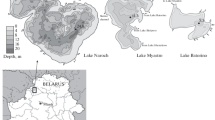Abstract
Analyses of the oligochaete fauna of two of the deepest lakes in Scandinavia — the Norwegian lakes Mjösa (450 m) and Tyrifjorden (295 m), revealed a totally different species composition in the deep profundal compared with the upper profundal - in contact with the nutrient-enriched epilimnion. In both lakes a pronounced thermal stratification develops in the summer, thus the epilimnion receiving gross organic pollution behaves differently from the profundal. The lakes are each effectively divided into two bodies of water with limited water exchange between them, i.e. one major oligotrophic body and one minor more nutrient-rich. Since the 1950s both lakes have been exposed to heavy pollution of various kinds. In Lake Mjösa in 1975 and 1976 unpleasant algal blooms of the blue-green alga Oscillatoria bornetii fa. tenuis occurred. Bottom samples obtained at the same time revealed that the deep central bottoms of the lake were totally dominated by oligotrophic oligochaete indicators, i.e. by Stylodrilus heringianus and Spirosperma ferox, while the fauna of the upper profundal in the vicinity of domestic and agricultural sewage outfalls, wood processing industries, etc. was dominated by Limnodrilus hoffmeisteri and Tubifex tubifex in great abundance, indicating enriched conditions. Several other species indicative of eutrophy, were absent, most of them belonging to the genus Potamothrix. A fairly similar situation exists in Lake Tyrifjorden, where, for instance, in the shallow bay of Steinsfjorden — heavily eutrophied by agricultural wastes — blooms of blue-green algae have caused problems from time to time. The same oligochaete communities as in Lake Mjösa distinguish the central oligotrophic bottoms from the regionally more enriched upper profundal. The likely reasons for an intact profundal oligochaete fauna are great volumes of oxygen-rich hypolimnic water of low temperature and a high bottom/lake surface area ratio.
Similar content being viewed by others
References
Berge, D. (ed.), 1983. Tyrifjorden. Tyrifjordundersökelsen 1978–1981. Sammanfattande slutrapport. NIVA, 156 pp.
Brinkhurst, R.O., 1966. The Tubificidae (Oligochaeta) of polluted water. Verh. Int. Ver. Limnol. 16: 854–859.
Edmondson, T.E., 1970. Phosphorus, nitrogen and algae in Lake Washington after diversion of sewage. Science 169: 690–691.
Holtan, H., 1979a. The Lake Mjösa Story. Arch Hydrobiol. Beih. 13: 242–258.
Holtan, H. 1979b. Mjosprosjektet. Hovedrapport for 1971–76. NIVA-rapport nr. 0-69091 (in Norwegian).
Holtan, H., 1981. Eutrophication of Lake Mjösa and its recovery. Wat. Qual. Bull., Vol. 6. No. 4.
Holtan, H., 1990. Lake Mjösa, Recipient and Ecosystem. Limnologica (Berlin) 20: 285–289.
Huitfeldt-Kaas, H., 1906. Planktonundersögelser i Norske Vande. Christiania, 199 pp.
Huitfeldt-Kaas, H., 1946. The plankton in Mjösa. Nytt. Mag. Naturvid. 85: 161–221.
Kjellberg, G., 1982. Overvåking av Mjösa. Bakgrunnsdata, historikk og videreforing. Del A. NIVA-rapport nr. 54/82, 104 pp. (in Norwegian).
Kjellberg, G., 1984. Studier av bunnfaunan i Tyrifjorden og Steinsfjordens profundalområder, Mai 1980. NIVA-rapport nr. 28/84, 20 pp. (in Norwegian).
Kjellberg, G., 1986. Overv»king av Mjösa. Sammendrag, trender og kommentarer 1976–85. NIVA-rapport nr. 241/86, 80 pp. (in Norwegian).
Lang, C., 1985. Eutrophication of Lake Geneva indicated by the oligochaete communities of the profundal. Hydrobiologia 126: 237–243.
Langeland, A., 1974. Long-term changes in the plankton of Lake Tyrifjord, Norway. Norw. J. Zool. 22: 207–219.
Liebmann, H. 1962. Handbuch der Frischwasser und Abwasserbiologie. Band I, R. Oldenbourg, München, 588 pp.
Lindström, E.A., R. Skulberg & O.M. Skulberg, 1973. Observations on planktonic diatoms in the lake-river system Lake Mjösa-Lake Öyeren-River Glåma, Norway. Norw. J. Bot. 29: 183–195.
Milbrink, G., 1980. Oligochaete communities in Pollution Biology. The European Situation with special reference to lakes in Scandinavia. In R.O. Brinkhurst & D.G. Cook (eds), Aquatic Oligochaete Biology. Plenum Press: 433–455.
Strom, K.M., 1930. Limnological observations on Norwegian Lakes. Arch. Hydrobiol. 21: 97–124.
Timm, T., 1980. Distribution of aquatic oligochaetes. In R.O. Brinkhurst & D.G. Cook (eds), Aquatic Oligochaete Biology. Plenum Press: 35–79.
Vollenweider, R.A., 1976. Advances in defining critical loading levels for phosphorus in lake eutrophication. Mem. Ist. ital. Idrobiol. 33: 53–83.
Vollenweider, R.A. & P.J. Dillon, 1974. The application of the phosphorus loading concept to eutrophication research. Canada Centre for Inland Waters, publ. No. NRCC 13690, 42 pp.
Wiederholm, T., 1976. Chironomids as indicators of water quality in Swedish lakes. NLU Information 10, 17 pp.
Author information
Authors and Affiliations
Rights and permissions
About this article
Cite this article
Milbrink, G. Oligochaetes and water pollution in two deep Norwegian lakes. Hydrobiologia 278, 213–222 (1994). https://doi.org/10.1007/BF00142329
Issue Date:
DOI: https://doi.org/10.1007/BF00142329




